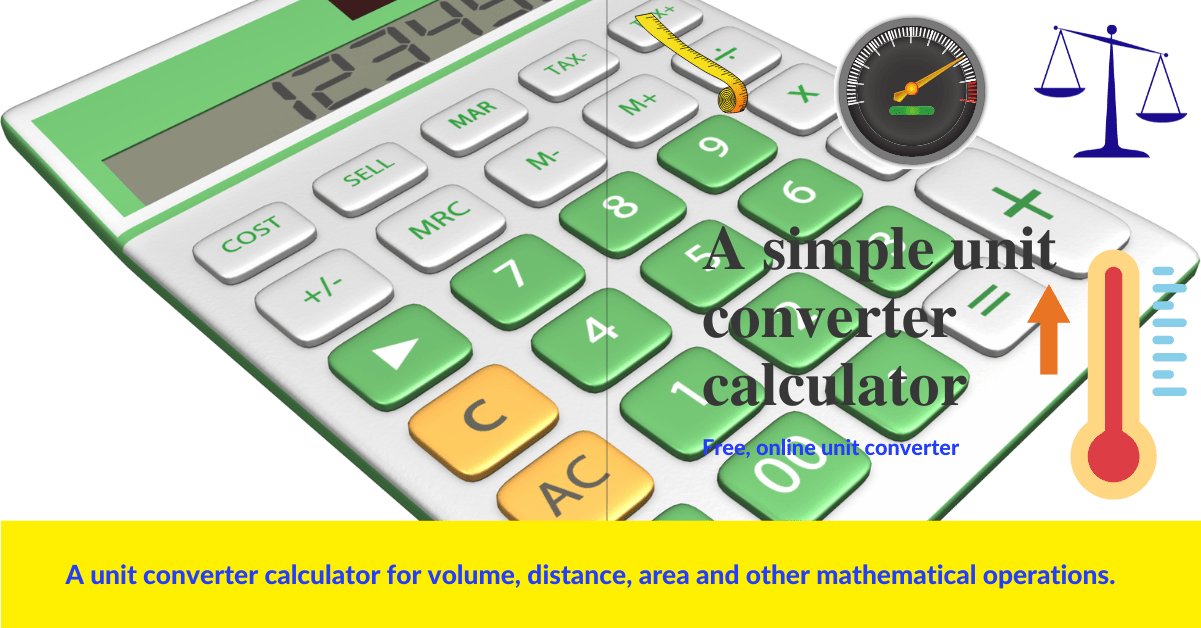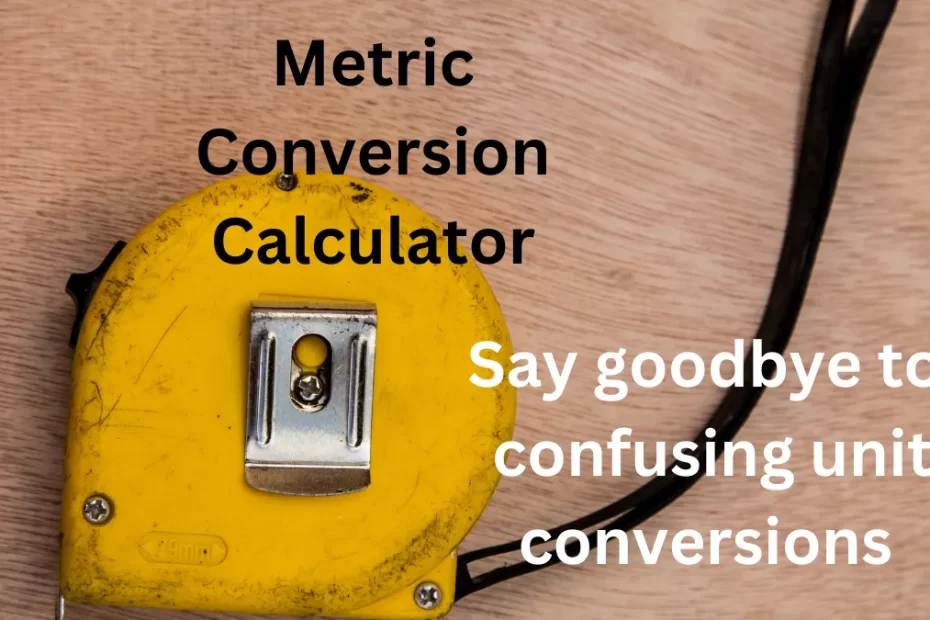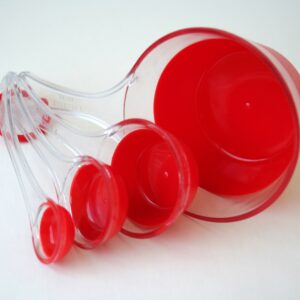The Ultimate Metric Conversion Calculator is a comprehensive tool that allows for precise and reliable conversion between different units of measurement within the metric system. It ensures accuracy by considering the specific conversion factors for each unit and providing easy-to-use functions for quick and error-free calculations.
This calculator guarantees precise measurements to convert length, weight, volume, or any other metric unit.
The Importance of Metric Conversion Calculator: Simplifying Measurements
Our Metric Conversion Calculator simplifies converting measurements from one metric unit to another, saving you time and ensuring accurate results.
Try it now to make your calculations hassle-free and precise.
The Importance of Metric Conversion Calculator: Simplifying Measurements
Easy Conversion Between Units:
- Online unit converters allow effortless conversion between various units of measurement.
- Metric conversion calculators are available online as websites or mobile apps, making it easy to access them whenever you need to make a quick conversion. You can have a conversion calculator with an internet connection or a smartphone wherever you go.
- Convert between length, weight, volume, temperature, and more with a few clicks. A metric conversion calculator typically offers a wide range of units to convert between, including length (meters, centimeters, inches), weight (kilograms, grams, pounds), volume (liters, milliliters, cups), and temperature (Celsius, Fahrenheit).
- This versatility makes it a versatile tool for a variety of conversion needs.
- There is no need for manual calculations or searching for conversion formulas.
- A metric conversion calculator on hand can be incredibly convenient for everyday use. Whether you’re cooking and need to convert between milliliters and ounces, or you’re traveling and need to convert kilometers to miles, a conversion calculator can make your life a lot easier.
Accessibility Anytime, Anywhere:
- Online unit converters are accessible 24/7, enabling you to convert units whenever needed.
- Accessible from any device with an internet connection, including smartphones, tablets, and computers.
- There is no need to install additional software or carry physical conversion charts.
Efficient and Time-Saving:
- With an online unit converter, conversions can be performed quickly and accurately.
- Instantly convert measurements without the need for complex calculations or reference materials.
- It saves valuable time, especially when dealing with multiple conversions or complex unit systems.
Universal Usage:
- Online unit converters provide conversions for different unit systems (e.g., metric, imperial), catering to diverse needs globally.
- Ideal for personal, educational, scientific, engineering, and professional purposes.
- Enables seamless communication and understanding across borders and industries.
Metric Conversion Calculator – Measurement Converter – Summary
An online unit converter offers easy accessibility, efficient conversion capabilities, time-saving convenience, and universal applicability. It simplifies measurement conversions and eliminates the need for manual calculations, making it an essential tool in today’s fast-paced world.
A quick, free, online unit converter (unit converter calculator) that converts standard units of measurement. A unit conversion expresses the same property as a different unit of measurement.
For instance, time can be expressed in minutes instead of hours, while distance can be converted from miles to kilometers, feet, or any other measure of length.
This is a simple unit converter calculator. Please enter a value in the input field; the calculator will convert it to another unit.

Measurement Converter – From Metric to U.S. Customary Measures
For example:
Length
| Symbol | When You Know | Multiply By | To Find | Symbol |
|---|---|---|---|---|
| mm | millimeter | 0.04 | inch | in |
| cm | centimeter | 0.39 | inch | in |
| m | meter | 3.28 | foot | ft |
| m | meter | 1.09 | yard | yd |
| km | kilometer | 0.62 | mile | mi |
Temperature
| Symbol | When You Know | Calculation | To Find | Symbol |
|---|---|---|---|---|
| °C | Celsius | multiply 1.8, then add 32 | Fahrenheit | °F |
| °K | Kelvin | subtract 273.15 | Celsius | °C |
Weight
| Symbol | When You Know | Multiply by | To Find | Symbol |
|---|---|---|---|---|
| g | gram | 0.04 | Ounce | oz |
| kg | kilogram | 2.20 | pound | lb |
Area
| Symbol | When You Know | Multiply By | To Find | Symbol |
|---|---|---|---|---|
| cm² | square centimeters | 0.16 | square inch | in² |
| m² | square inch | 1.20 | square yard | yd² |
| km² | square kilometer | 0.39 | square mile | mi² |
| ha | hectare (10,000 m2) | 2.47 | acre |
Volume
| Symbol | When You Know | Multiply By | To Find | Symbol |
|---|---|---|---|---|
| mL | milliliter | 0.03 | fluid ounce | fl oz |
| mL | milliliter | 0.06 | cubic inch | in³ |
| L | liter | 2.11 | pint liquid | pt |
| L | liter | 1.06 | quart liquid | qt |
| L | liter | 0.26 | gallon | gal |
| m³ | cubic meter | 35.31 | cubic foot | ft³ |
| m³ | cubic meter | 1.31 | cubic yard | yd³ |
Metric Conversion Calculator
Metric Conversion Calculator - Length Converter
Temperature Converter - Metric Conversion Calculator
Metric Conversion Calculator - Weight Converter
Ounces to Cups Conversion - Metric Conversion Calculator
Measure with Ease: Cups to Tablespoons, Precisely Please!
- Wondering how many tablespoons are in a cup? Look no further! One standard US customary cup is equal to 16 tablespoons. Whether you’re baking a delicate cake or following a savory recipe, this simple conversion ensures accurate measurements for culinary success.
Shopping Abroad? How to Convert Clothing Sizes and Weights from Ounces to Kilograms
When traveling internationally, understanding how to convert clothing sizes and item weights from ounces to kilograms can be crucial for making informed purchases. Whether you’re shopping for clothes, souvenirs, or other goods, knowing these conversions can help you avoid surprises at the checkout and ensure you comply with airline baggage policies.
Understanding Weight Conversions – Metric Conversion Calculator
The basic conversion you need to remember is that 1 ounce equals approximately 0.0283495 kilograms. For quick conversions while shopping, rounding to 0.03 kilograms for each ounce can simplify your calculations. Here’s a quick reference:
- 5 ounces = 0.14175 kg (approximately 0.14 kg)
- 10 ounces = 0.2835 kg (approximately 0.28 kg)
- 20 ounces = 0.567 kg (approximately 0.57 kg)
These conversions are beneficial when purchasing items that have weight restrictions or when you need to estimate shipping costs. Many stores abroad will list product weights in kilograms, but personal scales and conversion apps can assist if you’re dealing with ounces.
Converting Clothing Sizes
Clothing sizes can vary significantly by country. The US, UK, Europe, and Asia each have their sizing standards, which can be confusing. Try on clothing when possible or use online conversion charts specific to the brand or country. Typically, you’ll find that:
- US sizes are numerically higher than their UK counterparts by about 2 (a US size 8 is roughly a UK size 6).
- European sizes generally range from 32 to 34, higher than US sizes (a US size 8 is about a European size 40).
- Asian sizes can be more challenging as they may run smaller than US sizes by one or two sizes.
A conversion app or printed chart can be beneficial when shopping in international stores. These tools allow you to quickly convert your known size in your home country’s standard to the local sizing convention, reducing the risk of purchasing poorly fitting clothes.
The key to shopping abroad is preparation. Knowing these basic conversions and having tools can save you time and ensure a more enjoyable shopping experience.


